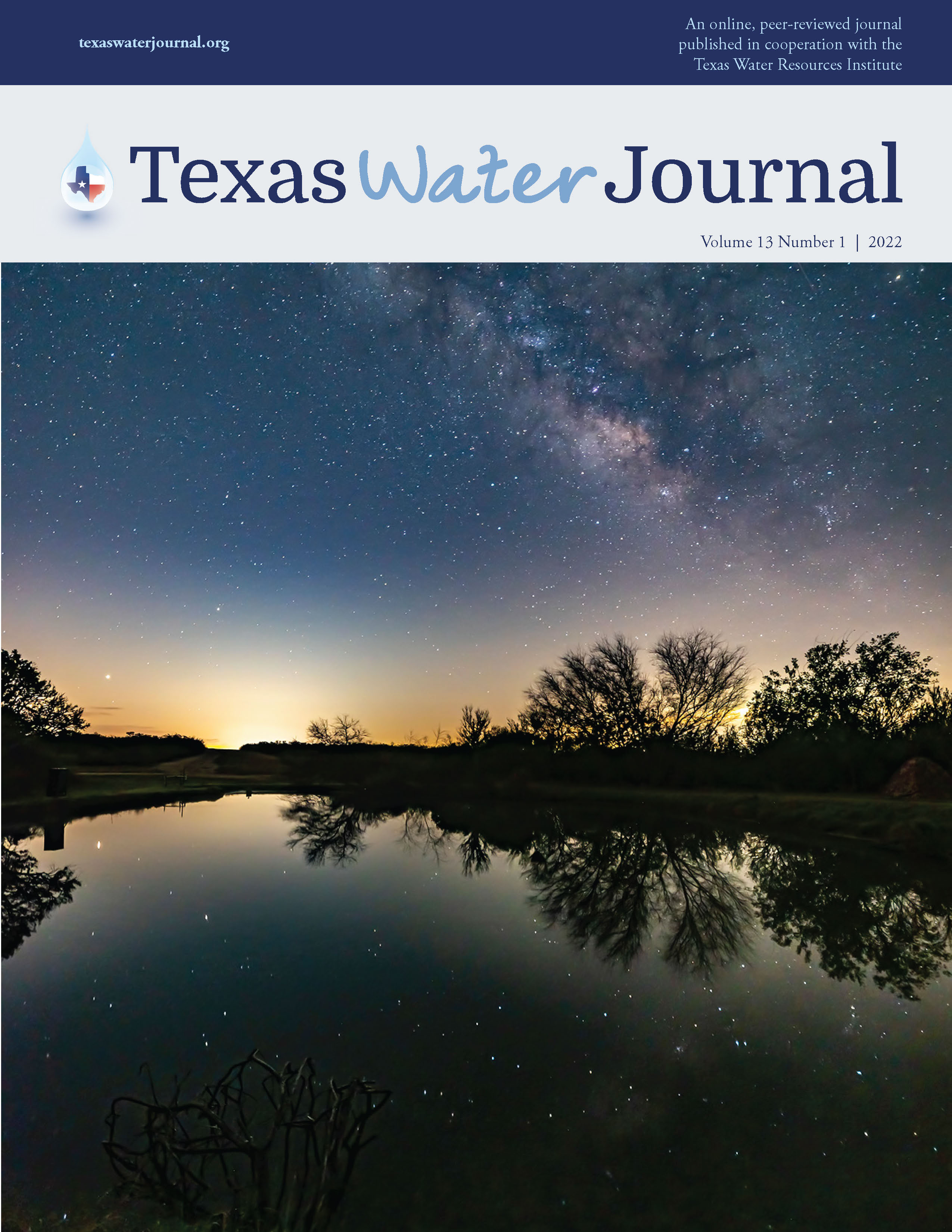Abstract
Maintaining an adequate water supply is one of the key challenges faced by the Dallas-Fort Worth Metroplex, where increasing population and rising water demand have elevated the vulnerability of the communities to water shortages. In this paper, we conducted a preliminary study exploring the possibility of converting flood storage in the Joe Pool Lake (JPL) as a means to improve water supply reliability and achieve better cost efficiency. This study employs a mixed integer linear programming (MILP) approach that considers the costs of meeting conversion demand and supply requirements over the northern portion of the Trinity River Basin. It includes trade-offs between capturing and storing natural flow versus return flow from the treatment facilities of the Trinity River Authority (TRA). A set of hypothetical prices and demand figures with the record drought of 1940-1996 considered to test the LP model. The optimal strategy yields expansion of JPL and associated storage-diversion on an annual basis. Also, the outcomes of the analyses suggest that, while the conversion would have a positive impact on water availability, storing the return flow might not produce sufficient cost savings; unless higher prices were imposed on the stored-return flow.
References
Asgari-Motlagh X, Ketabchy M, Daghighi A. 2019. Probabilistic quantitative precipitation forecasting using machine learning methods and probable maximum precipitation. International Journal of Engineering Science. 6(1):1-14. Available from: https://doi.org/10.9756/IAJSE/V6I1/1910001.
Cervellera C, Chen VCP, Wen A. 2006. Optimization of a large-scale water reservoir network by stochastic dynamic programming with efficient state space discretization. European Journal of Operational Research. 171(3):1139-1151. Available from: https://doi.org/10.1016/j.ejor.2005.01.022.
Cromarty AS, Ellis RH, Roberts EH. 1982. The design of seed storage facilities for genetic conservation. Rome (Italy): Bioversity International. Available from: https://hdl.handle.net/10568/104304.
Daghighi A, Nahvi A, Kim U. 2017. Optimal cultivation pattern to increase revenue and reduce water use: Application of linear programming to Arjan plain in Fars province. Agriculture. 07(09):73. Available from: https://doi.org/10.3390/agriculture7090073.
Daghighi A, Nahvi A, Nazif S, Kim U. 2020. Seeking substantiality: evaluation of public attitudes toward resilient wastewater reuse management. Journal of Water Management Modeling. 28: C470. Available from: https://doi.org/10.14796/JWMM.C470.
Demirel M, Wurbs RA. 2015. Assessment of flood control capabilities for alternative reservoir storage allocations. Turkish Journal of Water Sciences and Management. 1(1):108-137. Available from: https://doi.org/10.31807/tjwsm.297150.
Eusuff MM, Lansey KE. 2003. Optimization of water distribution network design using the shuffled frog leaping algorithm. Journal of Water Resources Planning and Management. 129(3):210-225. Available from: https://doi.org/10.1061/(ASCE)0733-9496(2003)129:3(210).
Ghahraman B, Sepaskhah AR. 2004. Linear and non‐linear optimization models for allocation of a limited water supply. Irrigation and Drainage. 53(1):39-54. Available from: https://doi.org/10.1002/ird.108.
Gheytaspour M, Habibzadeh Bigdarvish O. 2018. Forecasting oxygen demand in treatment plant using artificial neural networks. International Journal of Advanced Engineering Research and Science. 5(3):50-57. Available from: https://doi.org/10.22161/ijaers.5.3.8.
Ghimire MK. 2014. The impact of impoundment and urbanization on shallow groundwater conditions in the Joe Pool Lake catchment, Texas [dissertation]. [Arlington (Texas)]: University of Texas at Arlington. Available from: http://hdl.handle.net/10106/24927.
Haghiri S, Daghighi A, Moharramzadeh S. 2018. Optimum coagulant forecasting by modeling jar test experiments using ANNs. Drinking Water Engineering & Science. 11(1):1-8. Available from: https://doi.org/10.5194/dwes-11-1-2018.
LeComte D. 2020. U.S. weather highlights 2019: the second-wettest year on record. Weatherwise. 73(3):14-23. Available from: https://doi.org/10.1080/00431672.2020.1736464.
Naden R, Platt R. n.d. The Association of La Niña on Midland, Texas Precipitation. National Weather Service. [accessed 2021 May 21]. Available from: https://www.weather.gov/maf/research_lanina.
Nielsen-Gammon JW. 2012. The 2011 Texas drought. Texas Water Journal. 3(1):59-95. Available from: https://doi.org/10.21423/twj.v3i1.6463.
National Centers for Environmental Information. 2022. Climate at a Glance. Asheville (North Carolina): National Centers for Environmental Information. [accessed 2022 Jan 28]. Available from: https://www.ncdc.noaa.gov/cag/.
Pu B, Fu R, Dickinson RE, Fernando DN. 2016. Why do summer droughts in the Southern Great Plains occur in some La Niña years but not others? Journal of Geophysical Research: Atmospheres. 121(3)1120-1137. Available from: https://doi.org/10.1002/2015JD023508.
Reynolds RL, Rosenbaum JG, van Metre P, Tuttle M, Callender E, Goldin A. 1999. Greigite (Fe3S4) as an indicator of drought – The 1912–1994 sediment magnetic record from White Rock Lake, Dallas, Texas, USA. Journal of Paleolimnology. 21:193-206. Available from: https://doi.org/10.1023/A:1008027815203.
Samani HMV, Mottaghi A. 2006. Optimization of water distribution networks using integer linear programming. Journal of Hydraulic Engineering. 132(5):501-509. Available from: https://doi.org/10.1061/(ASCE)0733-9429(2006)132:5(501).
Slade RM. 2020. Runoff inflow volumes to the Highland Lakes in Central Texas: temporal trends in volumes, and relations between volumes and selected climatic indices. Texas Water Journal. 11(1):32-60. Available from https://doi.org/10.21423/twj.v11i1.7025.
[TWDB] Texas Water Development Board. 2017. Water for Texas 2017 state water plan. Austin (Texas): Texas Water Development Board. 150 p. Available from: https://www.twdb.texas.gov/waterplanning/swp/2017/index.asp.
[TWDB] Texas Water Development Board. 2019. State flood assessment: report to the 86th Texas Legislature. Austin (Texas): Texas Water Development Board. 58 p. Available from: http://www.texasfloodassessment.com/.
[TWDB] Texas Water Development Board. 2012. Water for Texas 2012 state water plan. Austin (Texas): Texas Water Development Board. 314 p. Available from: https://www.twdb.texas.gov/waterplanning/swp/2012/index.asp.
[USACE] U.S. Army Corps of Engineers. n.d. Fort Worth District – Joe Pool Lake. Fort Worth (Texas): U.S. Army Corps of Engineers Fort Worth District. [accessed 2022 Jan 27]. Available from: https://www.swf-wc.usace.army.mil/joepool/.
Wurbs RA. 2001. Assessing water availability under a water rights priority system. Journal of Water Resources Planning and Management. 127(4):235-243. Available from: https://doi.org/10.1061/(ASCE)0733-9496(2001)127:4(235).
Yaghoubi B, Hosseini SA, Nazif S, Daghighi A. 2020. Development of reservoir’s optimum operation rules considering water quality issues and climatic change data analysis. Sustainable Cities and Society. 63:102467. Available from: https://doi.org/10.1016/j.scs.2020.102467.
Yang T, Gao X, Sellars SL, Sorooshian S. 2015. Improving the multi-objective evolutionary optimization algorithm for hydropower reservoir operations in the California Oroville–Thermalito complex. Environmental Modelling & Software. 69:262-279. Available from: https://doi.org/10.1016/j.envsoft.2014.11.016.
Yeh WW‐G. 1985. Reservoir management and operations models: a state‐of‐the‐art review. Water Resources Research. 21(12):1797-1818. Available from: https://doi.org/10.1029/WR021i012p01797.

This work is licensed under a Creative Commons Attribution 4.0 International License.
Copyright (c) 2022 Srividya Sekar, Amin Daghighi, Victoria Chen, Glenn Clingenpeel, Yu Zhang, Jay Michael Rosenberger, Azam Boskabadi

